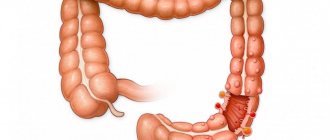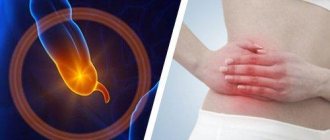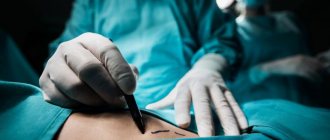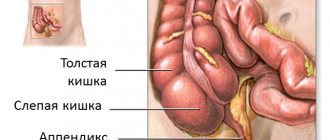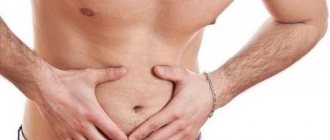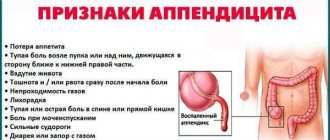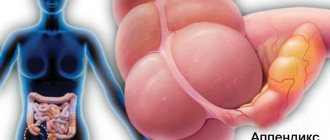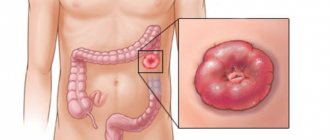What is gangrenous appendicitis
Appendicitis is an inflammation of the vermiform appendix (appendix) of the cecum.
Gangrenous appedicitis is characterized by irreversible destruction of the wall of the appendix
The gangrenous form usually represents the final stage of acute destructive appendicitis, in which the appendix undergoes irreversible destruction - complete necrosis of all layers of the appendix wall occurs in a limited area or throughout its entire length.
Inflammation may be accompanied by the appearance of holes in the wall of the appendix, in this case we are talking about gangrenous-perforated appendicitis. In this case, the appendix ruptures, and its purulent contents spread throughout the abdominal cavity, resulting in an increased risk of developing peritonitis (inflammation of the peritoneum - a thin membrane covering the internal walls of the abdominal cavity and the surface of the internal organs).
Appendicitis can occur at any age, but most often it occurs in people under the age of 40, and women are operated on more often than men.
The sooner you see a doctor, the better the prognosis. Acute appendicitis more than two days old is the main cause of death as a result of complications.
Gangrenous appendicitis requires urgent surgical intervention. With timely surgery, the prognosis for recovery is favorable.
Prevention
Specific preventive measures against the occurrence of such a disease are the timely elimination of acute appendicitis and other etiological factors, as well as regular medical examinations.
In the case of uncomplicated gangrenous appendicitis, the prognosis will be favorable, provided that adequate treatment is provided and the patient follows all the recommendations of the attending physician in the postoperative period.
The prognosis worsens significantly with the development of complications that can lead to death.
Causes and development factors
Gangrenous appendicitis can occur as either a primary or secondary disease.
Primary gangrenous appendicitis
The causes of primary gangrenous inflammation of the appendix are microcirculatory failures, which lead to circulatory disorders and, as a consequence, necrosis of the appendix . This is facilitated by:
- congenital vascular diseases in children - hypoplasia (underdevelopment) of the appendicular artery, which supplies the appendix with blood;
- age-related changes in blood vessels - typical for old age;
- atherosclerotic lesions of the walls of intestinal arteries;
- formation of blood clots in the veins and arteries of the appendix.
Secondary
The cause of secondary gangrenous appendicitis is the transition from a simple form to a destructive one as a result of inadequate or untimely surgical treatment according to the following scheme: catarrhal (simple) appendicitis -> superficial -> phlegmonous -> apostematous -> phlegmonous-ulcerative -> gangrenous -> perforated.
https://youtu.be/HHyzWT0YXBs
Complications
Since this disease does not have specific symptoms, and diagnosis and treatment are not carried out immediately after the first signs appear, quite often gangrenous appendicitis has a complicated course. The consequences of the disease include:
- perforation of the appendix;
- peritonitis;
- internal hemorrhages;
- intestinal obstruction;
- formation of abscesses and fistulas;
- portal vein thrombosis.
Postoperative complications may include wound suppuration and suture dehiscence.
Symptoms
The symptoms of gangrenous appendicitis are not always clear, so it is almost impossible to diagnose the disease based only on the clinical picture. Intoxication (poisoning with toxic substances) of the body occurs, which provokes major changes. In most cases, patients note:
- pain, initially bright in nature, becomes less pronounced, which is associated with the death of nerve endings, and when the appendix is perforated, the pain sharply intensifies and spreads throughout the abdomen;
- nausea, single or repeated vomiting;
- slight tension in the abdominal muscles;
- dry coated tongue;
- chills;
- hyperthermia (sharp increase in body temperature).
The first and main symptom of appendicitis is pain. Most often, it is initially felt in the umbilical region and epigastrium (epigastric region), and after some time it moves to the area of the inflamed appendix. In most cases, it is located in the right iliac region, although there are other options for its location.
Most often, pain is localized in the umbilical region and epigastrium
Features of symptoms in women
The general clinical picture of the disease in women may indicate both appendicitis and a number of other health problems, which is associated with frequent inflammatory processes in the genitals located in close proximity to the appendix, as well as changes in typical symptoms during pregnancy. This makes diagnosis difficult and increases the risk of complications.
In addition to general symptoms, the presence of appendicitis in women is often indicated by positive syndromes of Zhendrinsky, Promptov, Shilovets.
- According to Gendrinsky syndrome, with inflammation of the genitals, the pain that occurs when pressing on the Kümmel point (located 2 cm below the navel) in a lying position decreases after standing up with constant pressure on the abdominal wall. In acute appendicitis in women, on the contrary, increased pain is typical.
- Promptov's symptom is determined during vaginal examination - the cervix is grasped with two fingers, then oscillatory movements are made. When the appendages become inflamed, the pain intensifies; their absence indicates the presence of appendicitis.
- Shilovets syndrome is that when lying on your back, the place of greatest pain is determined in the right iliac region. After turning onto the left side, the pain moves lower.
Features of the clinical picture in children
It is especially difficult to determine appendicitis in children, especially the youngest. The clinical picture of the disease has been erased, and any delay can lead to dire consequences, since peritonitis develops much faster in children than in adults. The following symptoms may indicate appendicitis:
- decreased activity, lethargy, sleep disturbances;
- restlessness, constant crying;
- pulling the legs towards the stomach;
- increased body temperature;
- frequent bowel movements, vomiting, lack of appetite;
- pain when pressing on the abdomen;
- passive muscle tension in the right iliac region (can only be determined when the child is completely relaxed).
It should be remembered that these symptoms may indicate many other diseases, but in any case, if appendicitis is suspected, you should immediately consult a doctor.
How to identify appendicitis - video
When are stitches removed?
External sutures, provided there are no complications or suppuration, are removed on days 9–12. Internal sutures are made with catgut, which dissolves within 2 months.
The right side at the bottom is marked with a small seam of about 3 cm, as in the photo. Usually the suture after appendicitis remains in the form of a small line. But in some cases, it can turn into a scar after appendicitis, which disfigures the right side (shown in the photo). It all depends on the accuracy of following the doctor’s postoperative recommendations.
Diagnostics
It is almost impossible to determine the exact form of appendicitis (catarrhal, phlegmonous, gangrenous) based on symptoms and test results. Diagnosis is made intraoperatively (during the operation). This usually occurs at the first stage of laparotomy (an incision in the abdominal wall). A more gentle method is also sometimes used - diagnostic laparoscopy, in which, if inflammation is detected, the appendix is removed.
In a medical institution, only acute appendicitis is diagnosed, and not a specific form. To do this:
- urine and blood analysis - there is an increase in leukocytes, ESR, C-reactive protein in the blood 12 hours after the onset of disease progression, red blood cells and leukocytes appear in the urine, indicating toxic changes;
- ultrasound, computed tomography, x-ray;
- palpation (palpation) of the abdominal cavity (in children this is usually induced to sleep by medication) with digital examination of the rectum.
If it is impossible to make a diagnosis, the doctor, depending on the patient’s condition, decides on intraoperative diagnosis or leaves the patient for observation; if the condition worsens, surgery is performed.
Features of symptoms
With secondary appendicitis, the following symptoms may occur:
- repeated debilitating vomiting;
- slightly lower temperature;
- “toxic scissors” syndrome - normal temperature readings are associated with a clear increase in heart rate and a general serious condition;
- dry surface of the tongue, dense white coating closer to the root.
Doctor's note: this form of inflammation is very dangerous, since the death of tissue also affects the nerve endings, and therefore the painful sensations may temporarily subside, creating an imaginary situation where the problem has disappeared. This must be understood and taken into account.
If the gangrenous form of appendicitis is the primary disease, then the symptomatic manifestations will be somewhat different:
- during a heart attack, a sharp and very strong pain is felt in the right side, which quickly subsides due to the death of the nerves;
- irritated, painful stomach;
- high temperatures.
Symptoms do not differ by age or gender, but can be expressed to varying degrees depending on the individual characteristics of the body.
Treatment
For any form of acute appendicitis, surgical intervention is indicated. An emergency operation is performed to remove the appendix - appendectomy. This can be done in different ways:
- Standard - the abdominal cavity is opened, the appendix is removed and sent for histological examination to clarify the diagnosis, after which sutures and a bandage are applied to the incision.
Appendectomy - surgery to remove the appendix - Transluminal - the appendix is removed without damaging the skin through the natural openings of the human body using special flexible instruments (used extremely rarely).
- Laparoscopic - the appendix is removed using special instruments through small punctures in the abdominal wall. The method has the following advantages:
- maximum efficiency and safety;
- short period of hospitalization;
- quick recovery after surgery;
- minimal risk of infection.
Examination methods
The following methods are used for diagnosis:
- clinical tests of biofluids (blood, urine);
- physical examination with palpation of the abdomen;
- Ultrasound, CT - to obtain data on the general condition and shape of the diseased organ;
- radiography - to visualize the structure of the process;
- diagnostic laparoscopy is a mini-operation that allows you to simultaneously diagnose (by the thickening, greenish-black tint of the process of dead tissue) pathology and operate on the patient.
Detection of gangrene of the vermiform appendage is complicated due to blurred symptoms against the background of the death of nerve endings along with the tissues of the organ. The absence of pain makes patients think that the disease is receding.
Postoperative recovery
Recovery in the postoperative period for gangrenous appendicitis is characterized by increased supervision by medical staff, constant monitoring of the wound and blood tests. In addition, drug therapy is indicated.
Drug therapy - table
| Painkillers | Antibacterial | Detoxification | Preventive agents | |
| Effect of drugs | pain relief after surgery | suppression of the growth and reproduction of pathogenic bacteria | stopping or reducing the effect of toxic substances on the body | prevention of thromboembolic complications and stress ulcers of the stomach and intestines |
| Name of drugs |
|
|
|
|
Postoperative procedures
Procedures recommended after an appendectomy include:
- Exercise therapy (therapeutic physical culture) is a set of exercises aimed at working the muscles of the limbs;
- massage - the chest, back and limbs are developed;
- breathing exercises - special attention is paid to training chest breathing with an emphasis on exhalation.
Auxiliary folk remedies
The main remedies are painkillers, improve the functioning of the gastrointestinal tract, anti-inflammatory, restorative, and immunostimulating. Before using any traditional recipes, you should consult your doctor.
Important! No folk remedies can cure the gangrenous form of appendicitis, however, alternative medicine can significantly alleviate the patient’s condition during the rehabilitation period after surgery.
Folk remedies after appendicitis removal - table
| Name | Action | Mode of application |
| pharmaceutical camomile |
| 1–2 tbsp. l. dry herbs, pour a glass of boiling water, cover and let steep for 20–30 minutes, strain. Drink 3-5 times a day. Can be combined with other plants - calendula, mint, rose hips. |
| Calendula | bactericidal | 1 tbsp. l. pour a glass of boiling water over the flowers and leave in a steam bath for 5–10 minutes, consume 1/3 glass 3 times a day. |
| Peppermint |
| 1 tbsp. l. pour 1 cup of boiling water over the leaves, let it brew for 10–15 minutes, drink up to 3 cups a day. |
| Ginger root |
| Peel a piece of ginger, chop finely, put it in a thermos, add honey and lemon, pour boiling water over it, close it and leave overnight, drink a glass 3 times a day, preferably before meals. |
| Cranberries and lingonberries |
| Wipe the berries and pour boiling water over them, drink up to a liter of fruit drink throughout the day. |
| Dog-rose fruit | bactericidal | Place whole rose hips in a thermos at the rate of 2 handfuls per 0.5 liter, add hot water and leave overnight, then pass through a strainer or cheesecloth, add one teaspoon of sugar, drink throughout the day. |
| Decoctions of cumin, dill or fennel seeds | regulating the functioning of the gastrointestinal tract (helps with increased gas formation) | 1–2 tsp. pour a glass of boiling water, close and leave for 10 minutes, drink 1/2–1/3 glass 2–3 times a day. |
Folk remedies in the postoperative period - gallery
Rose hip
Cowberry
Ginger root
Peppermint
Calendula
pharmaceutical camomile
Lifestyle after surgery
After surgery to remove the appendix, you will need to adhere to a certain lifestyle for some time. Basic principles:
- with an uncomplicated form of gangrenous appendicitis, you can stand and walk 5-6 hours after surgery, and with gangrenous-perforated inflammation or a disease complicated by peritonitis - after 1-2 days;
- avoid any stress (including sexual contact) for a month after appendectomy;
- For the first month, avoid abdominal exercises, avoid prolonged standing, and do not lift heavy objects;
- Avoid alcohol for at least 3 weeks.
Return to work
After discharge from the hospital due to the removal of appendicitis, the patient must contact the surgeon at the clinic at his place of residence to extend his sick leave. For this purpose, the doctor is provided with an extract from the medical institution.
The duration of sick leave after appendicitis depends on the method of surgical intervention and the speed of the person’s recovery.
Laparoscopic surgery involves a short period of rehabilitation - within 5-8 days. This period includes hospital stay and outpatient recovery after the intervention.
After abdominal surgery, you can open a certificate of incapacity for work for 10-14 days. If complications occur, the length of stay on sick leave increases significantly. In this case, the document is issued on the basis of the conclusion of a special commission, since this requires serious reasons.
It takes up to 4-6 weeks for a patient to fully recover after appendectomy. During this period, he must adhere to the doctor's recommendations. However, after the sick leave is closed, he can begin to work.
When can you start playing sports after appendicitis?
What form does appendicitis manifest in: symptoms in adults and diagnosis
Surgery for appendicitis: benefits and harms
Can a patient have appendicitis for a week?
Surgical removal of the appendix is the only way to cure appendicitis. Despite its apparent simplicity, this is a full-fledged operation that traumatizes the body and requires a full recovery period. Rehabilitation after appendicitis in adults includes following a diet and regulating physical activity. Only under these conditions will the appendix never remind itself of itself again.
Diet after appendectomy
Gangrenous appendicitis provokes disturbances in intestinal motility (contraction of the walls responsible for moving the food contents of the intestine to the exit), and when operating on this form of the disease, there is a high probability of surgical injury to the abdominal organs. All this can lead to a slowdown in digestive processes and problems with stool and be complicated by intestinal obstruction. This should be taken into account when organizing meals.
Basic Rules:
- For the first day, it is advisable to drink only liquid - ordinary purified water or mineral water without gas, weak sweet tea, decoctions of rose hips, dried fruits, compotes.
- With a good recovery trend, you can add weak broths, pureed soups and lean meats, mashed potatoes, and thin porridges to the menu.
- If the process of defecation (emptying the rectum) is improving and there are no problems with the intestines, you can switch to an expanded diet excluding fatty, spicy, fried and smoked foods.
Principles of nutrition after appendectomy:
- the menu should be balanced in the content of proteins, fats and carbohydrates;
- you should eat in small portions 5–6 times a day, preferably at the same time;
- it is necessary to drink enough liquid per day;
- You need to avoid foods that cause increased gas formation (cabbage, legumes, etc.)
Importance of Nutrition
With gangrene of the intestinal appendix, the functioning of the gastrointestinal tract worsens and metabolism slows down. Therefore, a liquid diet is recommended for the first 24 hours. Still water and sweet tea are allowed. In the evening (as you feel better) - kefir, pureed chicken broth.
On the second day, it is allowed to add mashed potatoes and mashed cutlets, porridge with butter, and cottage cheese casseroles. If signs of inflammation persist, you can extend the diet of the first day.
On the third day, in most cases, the intestines begin to function as usual, and the patient can go to the toilet on his own. From this day on, the recommended diet is medical table No. 5.
The diet after gangrenous appendicitis involves avoiding animal protein and fat. Preference is given to light plant foods. It is necessary to exclude marinades, smoked and fried foods. Meals should be frequent and in small portions. You also need to exclude baked goods, desserts (chocolate, halva, condensed milk), store-bought juices, soda, and cold dishes.
After surgical treatment, the patient should quit smoking and alcoholic beverages
Preference is given to dairy products, cereals, and light vegetable broths. It is better to exclude fruits, especially sour ones, and hot sauces. It is important not to overload the gastrointestinal tract and not provoke cholecystitis or pancreatitis. An example of a daily diet at table No. 5 is presented in table form.
| Breakfast | Oatmeal with a piece of butter, weak tea with lemon, crackers. |
| Lunch | Berry puree, fruit drink. |
| Dinner | Puree vegetable soup, a piece of rye bread, rice, steamed cutlet, chamomile infusion, dry biscuit. |
| Afternoon snack | Curd soufflé, jelly. |
| Dinner | Pasta with steamed fish, rosehip infusion |
| Second dinner | Natural yogurt. |
The trial period of the diet is 5 days. If the body reacts normally, it can be continued for several years.
After surgery, be sure to follow nutritional recommendations for at least 1.5 months! It is important to give up alcohol and cigarettes.
After watching the video, you will learn in more detail about the causes of gangrenous appendicitis, the characteristics of its course, signs and methods of treating the pathology:
https://youtu.be/M95Br62aik8
